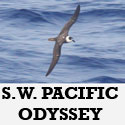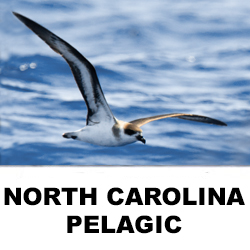|
 The purpose of this trip for us, was twofold, obviously to get some close-up views of cetaceans, and also hopefully to see certain
seabirds restricted to this area of the world. In the first the trip was an outstanding success, but unfortunately due to El Nino
activity the previous year, the waters were colder than usual and this affected the migration of the smaller species, notably storm-petrels,
which were very thin on the ground (water?). However, there were still plenty of birds to see, including several impressive species.
By contrast cetacean sightings were outstanding, read on if you dare.
The purpose of this trip for us, was twofold, obviously to get some close-up views of cetaceans, and also hopefully to see certain
seabirds restricted to this area of the world. In the first the trip was an outstanding success, but unfortunately due to El Nino
activity the previous year, the waters were colder than usual and this affected the migration of the smaller species, notably storm-petrels,
which were very thin on the ground (water?). However, there were still plenty of birds to see, including several impressive species.
By contrast cetacean sightings were outstanding, read on if you dare.
We arrived in San Diego luggage-less, courtesy of American Airlines. However, they seem to have a bit more idea than some carriers and
were fairly sure it would catch up with us the next day. If booking this trip through Wildwings, they factor in a day to cover such
eventualities, this otherwise being taken up with a local birding tour. The people affected by the lack of luggage were asked if they
wanted to hang around and make sure it did arrive, or go on the birding trip. They were obviously all birders, since all opted for
the tour. San Diego has a lot of areas suitable for birding, without travelling far, so whilst most birds weren't new for those that had
been to the states before, it provided plenty of enjoyment.
 I have to say that we had two guides on this trip, one was an excellent cetacean expert, whilst the other was an all-round naturalist.
Unfortunately, the naturalist also suffered from what we call "Macho-birder syndrome" in that they think they know a lot and you don't,
because you have employed them as a guide. Whilst this can lead to awkward moments, we usually find it quite amusing. An example of this
was when we called in to a local park to be told "there's supposed to be a Great Horned Owl in these trees, but I've been here four times
and never found it, so we'll carry on to the lake." Within two minutes Ann had found it, to the delight of the rest of the group, although
I have to say they weren't the best views we've ever had. The park and surrounding area was quite productive, with Cinnamon Teal, Bufflehead,
Ring-necked Duck and Wood Duck on the lake, Great-tailed Grackle at water's edge (the reason for the visit, being quite restricted in
range in the states) and a Cliff Swallow colony nearby. One noteworthy fact was that the ducks weren't being fed, the Wood Ducks were
wild, but none were particularly wary and one male Wood Duck was alighting on a park bench! So are they all escapes in England?
I have to say that we had two guides on this trip, one was an excellent cetacean expert, whilst the other was an all-round naturalist.
Unfortunately, the naturalist also suffered from what we call "Macho-birder syndrome" in that they think they know a lot and you don't,
because you have employed them as a guide. Whilst this can lead to awkward moments, we usually find it quite amusing. An example of this
was when we called in to a local park to be told "there's supposed to be a Great Horned Owl in these trees, but I've been here four times
and never found it, so we'll carry on to the lake." Within two minutes Ann had found it, to the delight of the rest of the group, although
I have to say they weren't the best views we've ever had. The park and surrounding area was quite productive, with Cinnamon Teal, Bufflehead,
Ring-necked Duck and Wood Duck on the lake, Great-tailed Grackle at water's edge (the reason for the visit, being quite restricted in
range in the states) and a Cliff Swallow colony nearby. One noteworthy fact was that the ducks weren't being fed, the Wood Ducks were
wild, but none were particularly wary and one male Wood Duck was alighting on a park bench! So are they all escapes in England?
We visited about six different sites during the day, all quite close together, and saw over a hundred species, other highlights included
Cooper's Hawk, Western and Least Sandpipers, Glaucous-winged Gull, Elegant Tern, White-throated Swift,
Pacific-slope Flycatcher, Cassin's
Kingbird, Western Bluebird, Cedar Waxwing and several Dendroica Warblers.
 We left after an evening meal on our boat, a 75ft sport-fishing job with 16 passenger berths, and were able to see a few birds over bait-tanks on
our way out. These included Brandt's Cormorants, found only on the West Coast, plus various Herons
Egrets and Brown Pelicans. Also apparent were California Sea-lions. The following morning saw
us at Ensenada Harbour to clear customs at 5:30am, we had to wait for customs officials to arrive. We then journeyed to nearby Todos Santos island to view the
cliffs, where about 300 Brandt's Cormorants hid a Pelagic Cormorant.
Unfortunately we experienced our only period of bad sea-conditions as we ventured south, and Ann and I
took to our cabins, with occasional forays on deck to check we weren't missing anything. A few species were apparent, but unfortunately we later
discovered that the tannoy system on this boat only works for really exceptional cetacean sightings, and not for birds at all! A day later we found
we had missed a Black-footed Albatross sitting on the water! I know it is advertised as a Whale-watching trip but I do think the guides could have been a
bit more thoughtful. Something to bear in mind if you decide to follow in our footsteps.
We left after an evening meal on our boat, a 75ft sport-fishing job with 16 passenger berths, and were able to see a few birds over bait-tanks on
our way out. These included Brandt's Cormorants, found only on the West Coast, plus various Herons
Egrets and Brown Pelicans. Also apparent were California Sea-lions. The following morning saw
us at Ensenada Harbour to clear customs at 5:30am, we had to wait for customs officials to arrive. We then journeyed to nearby Todos Santos island to view the
cliffs, where about 300 Brandt's Cormorants hid a Pelagic Cormorant.
Unfortunately we experienced our only period of bad sea-conditions as we ventured south, and Ann and I
took to our cabins, with occasional forays on deck to check we weren't missing anything. A few species were apparent, but unfortunately we later
discovered that the tannoy system on this boat only works for really exceptional cetacean sightings, and not for birds at all! A day later we found
we had missed a Black-footed Albatross sitting on the water! I know it is advertised as a Whale-watching trip but I do think the guides could have been a
bit more thoughtful. Something to bear in mind if you decide to follow in our footsteps.
Other seabirds seen that day included
Sooty, Pink-footed and Black-vented Shearwaters, this last being only found in this part of the world. A number of
distant cetacean sightings were made, of species that we would see much better later. Most seabirds on this trip can be better seen in other ways, but
if you've not visited this area it's possible to see quite a few. Storm petrels are problematic, since newly split species such as Ainley's are very
difficult to distinguish from other "dark-rumped Leach's" types, but our trip saw only Black. There was a reason for this, as birds are returning to their
breeding areas and the water temperature has a major bearing on numbers. Most trips do in fact see more seabirds.
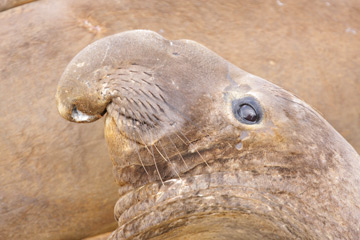 My personal log tells me I also recorded Sabine's Gull, Grey Phalarope and Xantu's Murrelet,
but all were quite distant and as none was a lifer I wasn't too upset. The following day saw us still in quite a swell but just north of the San Benitos
islands, where we made a landing. Our first good views of mammals were made here, in the shape of Northern Elephant Seals and,
more importantly, Guadalupe Fur Seals.This species was thought to be extinct at one time but has recovered somewhat and has bred here
for about ten years, although still listed as endangered. The same cannot be said for the Guadalupe Storm-petrel, which unfortunately remains unseen since
1921. Birds seen were all species found in the USA, such as Black and American Oystercatcher, Black Turnstone, Hudsonian Whimbrel,
American Kestrel and Western Gull. A tick for Ann came in the shape of two Cassin's Auklets, , albeit
fairly distant. Leaving the islands to the south a few people had a brief view of a Minke Whale
, and as sunset approached we saw numbers of Black-vented Shearwaters. Minke whales are rarely seen well here, as they seem far less tolerant of boats
than in the Atlantic, however this doesn't apply further south, where they may well be a different species (Antarctic Minke).
We awoke the next morning to much calmer seas, at the entrance to San Ignacio Lagoon, which was to be the highlight of the trip. San Ignacio Lagoon is world-famous
as a breeding area for Grey Whales, you may indeed have seen it on TV where it is becoming increasing popular to send
a glamorous presenter to touch the whales. Believe us, nothing can prepare you for, nor diminish this experience of tickling or patting a Grey Whale on the nose,
the more so because it's the whales that approach your boat, not vice versa!
My personal log tells me I also recorded Sabine's Gull, Grey Phalarope and Xantu's Murrelet,
but all were quite distant and as none was a lifer I wasn't too upset. The following day saw us still in quite a swell but just north of the San Benitos
islands, where we made a landing. Our first good views of mammals were made here, in the shape of Northern Elephant Seals and,
more importantly, Guadalupe Fur Seals.This species was thought to be extinct at one time but has recovered somewhat and has bred here
for about ten years, although still listed as endangered. The same cannot be said for the Guadalupe Storm-petrel, which unfortunately remains unseen since
1921. Birds seen were all species found in the USA, such as Black and American Oystercatcher, Black Turnstone, Hudsonian Whimbrel,
American Kestrel and Western Gull. A tick for Ann came in the shape of two Cassin's Auklets, , albeit
fairly distant. Leaving the islands to the south a few people had a brief view of a Minke Whale
, and as sunset approached we saw numbers of Black-vented Shearwaters. Minke whales are rarely seen well here, as they seem far less tolerant of boats
than in the Atlantic, however this doesn't apply further south, where they may well be a different species (Antarctic Minke).
We awoke the next morning to much calmer seas, at the entrance to San Ignacio Lagoon, which was to be the highlight of the trip. San Ignacio Lagoon is world-famous
as a breeding area for Grey Whales, you may indeed have seen it on TV where it is becoming increasing popular to send
a glamorous presenter to touch the whales. Believe us, nothing can prepare you for, nor diminish this experience of tickling or patting a Grey Whale on the nose,
the more so because it's the whales that approach your boat, not vice versa!
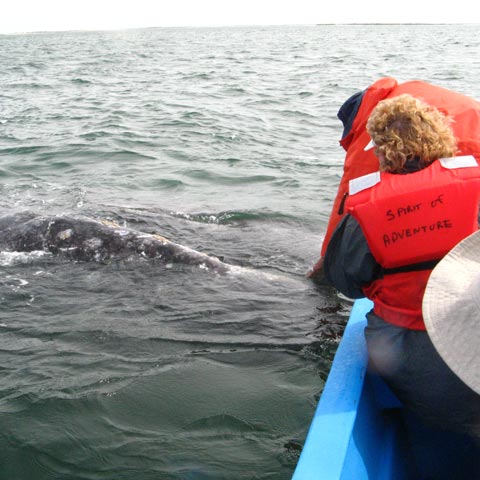

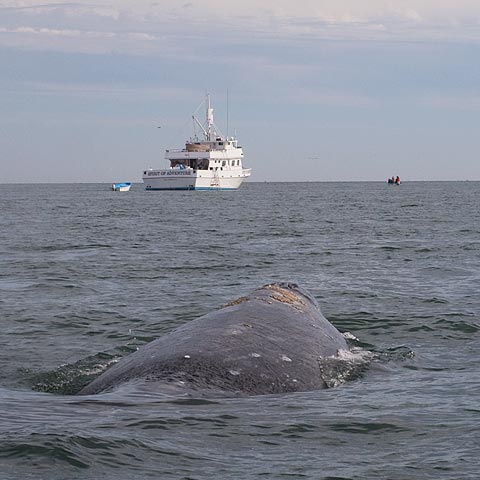 It is usually the calves (3-4 months old) that come close, but we were actually very lucky and had an interaction with a female as well. The mother and calf
always stay together, but mum usually stays in the background. This happened on our
first day, you are taken out in pangas which are small motorised skiffs originally used for fishing, and the whales come to you. If you try to approach
them they may reciprocate, but equally often will dive and leave the immediate area. Obviously only certain females are habituated, but there is never any
pressure, sit and wait and one will come. It is thought that the habit arose because of familiarity with fisherman, who were originally scared of the whales, but
over the years the two species became habituated to each other, with the result that much of the local's time now is taken up ferrying tourists, which will also
presumably have a beneficial effect on fish stocks.
An interesting "game" has been developed by the young whales, although how knowledge of it is passed on is a fascinating mystery. It seems that they are
attracted by noise, especially the squeals and screams made by American tourists, and have learnt that the squeals increase if the tourists get wet. So,
they sink just below the surface and collect water in the depression around their blowholes. When they breathe out they can direct the spume to a degree,
so effectively have a monster, live water-pistol which can be directed at those in the boat! This is largely theoretical, but we have seen them do it, and it is
quite definitely deliberate. They can't distinguish between nationalities, as we can vouch from experience, I'm sure they're laughing but have no way to
prove such anthropomorphism.
It is usually the calves (3-4 months old) that come close, but we were actually very lucky and had an interaction with a female as well. The mother and calf
always stay together, but mum usually stays in the background. This happened on our
first day, you are taken out in pangas which are small motorised skiffs originally used for fishing, and the whales come to you. If you try to approach
them they may reciprocate, but equally often will dive and leave the immediate area. Obviously only certain females are habituated, but there is never any
pressure, sit and wait and one will come. It is thought that the habit arose because of familiarity with fisherman, who were originally scared of the whales, but
over the years the two species became habituated to each other, with the result that much of the local's time now is taken up ferrying tourists, which will also
presumably have a beneficial effect on fish stocks.
An interesting "game" has been developed by the young whales, although how knowledge of it is passed on is a fascinating mystery. It seems that they are
attracted by noise, especially the squeals and screams made by American tourists, and have learnt that the squeals increase if the tourists get wet. So,
they sink just below the surface and collect water in the depression around their blowholes. When they breathe out they can direct the spume to a degree,
so effectively have a monster, live water-pistol which can be directed at those in the boat! This is largely theoretical, but we have seen them do it, and it is
quite definitely deliberate. They can't distinguish between nationalities, as we can vouch from experience, I'm sure they're laughing but have no way to
prove such anthropomorphism.
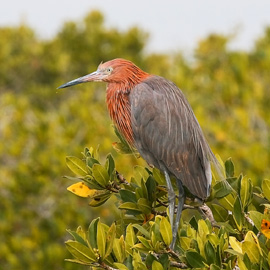 Our second day in the lagoon started with a trip to the mangrove area on one shoreline, basically for birds. On the journey we had good views of
Great Northern Diver (here in breeding plumage), Royal Terns, and Surf Scoters.
We had seen lots of birds the previous afternoon, but no-one took much notice! Bottlenose Dolphins were also much in evidence.
The actual trip through the mangroves produced many more species, including every Heron on the American list, the best of these being Reddish Egret,
Yellow-crowned Night-heron and Tricoloured Heron, this last being somewhat distant.White Ibises
were also much in evidence. A speciality was Mangrove Warbler, a potential split from Yellow, and Clapper Rail
was a good record. (This has subsequently become Ridgway's Rail, Clapper now refers to birds further east).
Waders were much in evidence, including Willett, Long-billed Curlew,
Marbled Godwit and Short-billed Dowitcher. Greater Yellowlegs in breeding
plumage were also around, further re-inforcement that this wasn't a birding trip came when I identified a Dowitcher, only to be corrected by one of the guides
saying it was a Yellowlegs. When I asked why, I was told "because it's got yellowish legs"! To be fair, it was still in winter plumage, with no visible orange.
If anyone wants to see a photo of the bird, it's in the waders section
under Short-billed Dowitcher, as is Greater Yellowlegs also under the correct title.
That afternoon was spent with more Grey Whale interactions, and in the evening we said goodbye to our panga drivers and the magical San Ignacio Lagoon, to sail
further south, accompanied by a superb sunset.
Our second day in the lagoon started with a trip to the mangrove area on one shoreline, basically for birds. On the journey we had good views of
Great Northern Diver (here in breeding plumage), Royal Terns, and Surf Scoters.
We had seen lots of birds the previous afternoon, but no-one took much notice! Bottlenose Dolphins were also much in evidence.
The actual trip through the mangroves produced many more species, including every Heron on the American list, the best of these being Reddish Egret,
Yellow-crowned Night-heron and Tricoloured Heron, this last being somewhat distant.White Ibises
were also much in evidence. A speciality was Mangrove Warbler, a potential split from Yellow, and Clapper Rail
was a good record. (This has subsequently become Ridgway's Rail, Clapper now refers to birds further east).
Waders were much in evidence, including Willett, Long-billed Curlew,
Marbled Godwit and Short-billed Dowitcher. Greater Yellowlegs in breeding
plumage were also around, further re-inforcement that this wasn't a birding trip came when I identified a Dowitcher, only to be corrected by one of the guides
saying it was a Yellowlegs. When I asked why, I was told "because it's got yellowish legs"! To be fair, it was still in winter plumage, with no visible orange.
If anyone wants to see a photo of the bird, it's in the waders section
under Short-billed Dowitcher, as is Greater Yellowlegs also under the correct title.
That afternoon was spent with more Grey Whale interactions, and in the evening we said goodbye to our panga drivers and the magical San Ignacio Lagoon, to sail
further south, accompanied by a superb sunset.
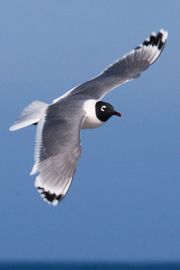
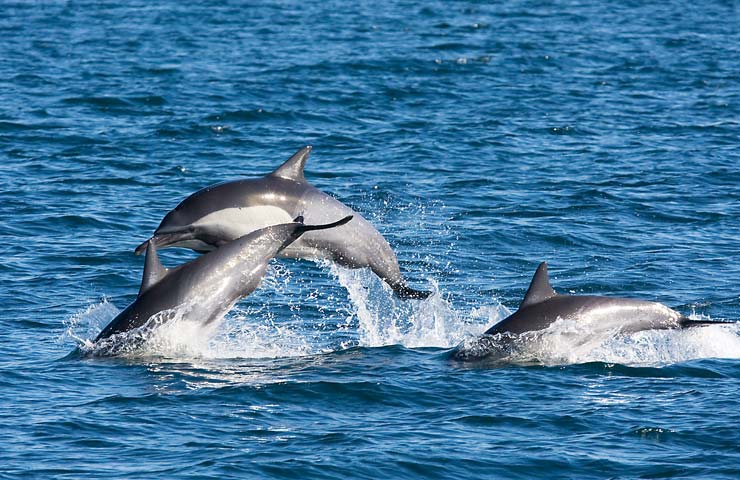 The following morning we were off Punta Lazaro, still in the Pacific but only just. Just after breakfast we had our first sighting of Blue Whales
, a pair, but as the sea was still a bit choppy decided not to follow them. A few years ago that would have been a bit silly, as sightings weren't guaranteed,
but more recently they are seen on just about every trip in some numbers (by whale standards). We ended up seeing about fifteen. As we continued south we
saw more Black-vented, Pink-footed and Sooty Shearwaters, and a small pod of our first Long-beaked Common Dolphins. Common
Dolphins have recently been split in to two species, but we never saw the Short-beaked. One of our guides then tried to do their equivalent of chumming,
using stale bread! Being a cetacean trip they obviously were unaware that chum works because seabirds smell it from a distance, but we did manage to
attract some gulls and a couple of Magnificent Frigatebirds. Most of the gulls were California Gulls,
sadly a Heermann's Gull was immature, but we had superb views of three adult Franklin's Gulls.
We saw few other birds that day, except a small flock of Bonaparte's Gulls, but made up for it with a cow-calf pair of
Humpback Whales, which breached in the distance but refused to let us get any closer, and a further five individual Blue
Whales. An evening highlight came in the shape of about three hundred Long-beaked Common Dolphins, which came to play as we approached, riding the
bow-wave, leaping in groups and individually, generally making "Seaworld" look very tame (which of course it is, and not the same at all.)
When we awoke the next morning we were cruising over an area called the Gorda Bank, an undersea mount in the Sea of cortez. A larger, more
robust form of Bottlenose Dolphin (offshore) was much in evidence swimming alongside the boat for the first two hours of daylight. Whether this form will
one day be split from the inshore ones I haven't a clue, but if avian taxonomy is anything to go by it seems likely. The main attraction of this area is
Humpback Whales, we saw two different groups which showed well if a little distantly, and we had good views of the varying patterns of their flukes as
they dived. We did see one breach, for which this species is well known, but it was distant and against the light. C'est la vie!
During the morning we had our first view of Manta Rays, specifically Spiny-tailed Mobulas. These superb fish seem to be little
known, even their name seems to have varying spellings, one of which was in our checklist(moghula). Both our guides and the checklist only seemed to be
interested in one species, but it became quite apparent later that two were frequently seen, differing in both size and behaviour. On doing a bit of research
on returning home I found this to indeed be the case, the smaller, more active species appeared in some numbers in a different area. Another superb fish
which appeared alongside our vessel was the first of three Scalloped Hammerhead Sharks, on consecutive days, looking very
brownish in colour. But of seabirds there was very little, the only species seen were ones seen commonly most days, although when going through photos
later I think we may have "thrown away" a Townsend's Shearwater.
The following morning we were off Punta Lazaro, still in the Pacific but only just. Just after breakfast we had our first sighting of Blue Whales
, a pair, but as the sea was still a bit choppy decided not to follow them. A few years ago that would have been a bit silly, as sightings weren't guaranteed,
but more recently they are seen on just about every trip in some numbers (by whale standards). We ended up seeing about fifteen. As we continued south we
saw more Black-vented, Pink-footed and Sooty Shearwaters, and a small pod of our first Long-beaked Common Dolphins. Common
Dolphins have recently been split in to two species, but we never saw the Short-beaked. One of our guides then tried to do their equivalent of chumming,
using stale bread! Being a cetacean trip they obviously were unaware that chum works because seabirds smell it from a distance, but we did manage to
attract some gulls and a couple of Magnificent Frigatebirds. Most of the gulls were California Gulls,
sadly a Heermann's Gull was immature, but we had superb views of three adult Franklin's Gulls.
We saw few other birds that day, except a small flock of Bonaparte's Gulls, but made up for it with a cow-calf pair of
Humpback Whales, which breached in the distance but refused to let us get any closer, and a further five individual Blue
Whales. An evening highlight came in the shape of about three hundred Long-beaked Common Dolphins, which came to play as we approached, riding the
bow-wave, leaping in groups and individually, generally making "Seaworld" look very tame (which of course it is, and not the same at all.)
When we awoke the next morning we were cruising over an area called the Gorda Bank, an undersea mount in the Sea of cortez. A larger, more
robust form of Bottlenose Dolphin (offshore) was much in evidence swimming alongside the boat for the first two hours of daylight. Whether this form will
one day be split from the inshore ones I haven't a clue, but if avian taxonomy is anything to go by it seems likely. The main attraction of this area is
Humpback Whales, we saw two different groups which showed well if a little distantly, and we had good views of the varying patterns of their flukes as
they dived. We did see one breach, for which this species is well known, but it was distant and against the light. C'est la vie!
During the morning we had our first view of Manta Rays, specifically Spiny-tailed Mobulas. These superb fish seem to be little
known, even their name seems to have varying spellings, one of which was in our checklist(moghula). Both our guides and the checklist only seemed to be
interested in one species, but it became quite apparent later that two were frequently seen, differing in both size and behaviour. On doing a bit of research
on returning home I found this to indeed be the case, the smaller, more active species appeared in some numbers in a different area. Another superb fish
which appeared alongside our vessel was the first of three Scalloped Hammerhead Sharks, on consecutive days, looking very
brownish in colour. But of seabirds there was very little, the only species seen were ones seen commonly most days, although when going through photos
later I think we may have "thrown away" a Townsend's Shearwater.

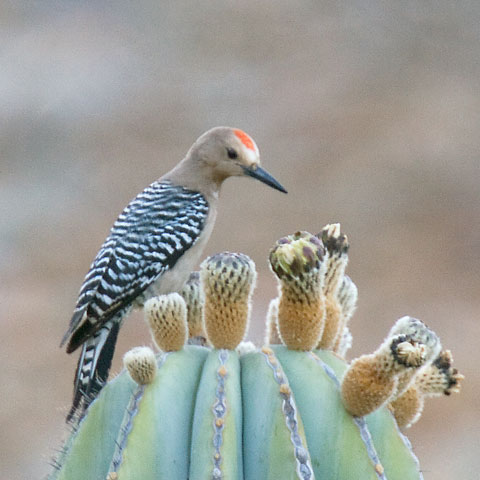 In the afternoon we landed at a place called Los Frailles, although how it came to have a name wasn't evident, being exactly the same as the desert all around.
The desert of Baja is in fact rich in wildlife and plants, especially magnificent cacti, being completely unlike the popular conception of a desert. Come to think
of it, there were a few dwellings around, presumably it was a spread-out village. We probably saw more species of landbird here than any other area, although
most were readily viewable in California USA. As we walked up from the boat a Cactus Wren performed nicely in its chosen bush, and
as we walked around we came across such desert species as Verdin, Ladder-backed Woodpecker and
White-winged Dove. An area of bushes near a local dwelling produced several sparrows, mainly
White-crowned and Lark Sparrows, but we did have an unexpected "tick" in the form of a
Clay-coloured Sparrow somewhat out of range. It was here we recorded our only land mammal, a Black-tailed Jack Rabbit.
Our first endemic, a Grey Thrasher, turned out to be the only one of the trip,
unfortunately being quite distant for Ann & I, although others saw them better. Other species of interest included Hooded Oriole,
California Gnatcatcher,
Orange-crowned Warbler, Green-tailed Towhee, Northern Cardinal and
Grey Flycatcher.
Whilst walking back to the boat a Pyrrhuloxia was singing close to the track, although expected, this was in fact our only one.
A last-minute addition was a Northern Caracara which flew overhead as the stragglers (which always includes us) returned to the vessel.
In the afternoon we landed at a place called Los Frailles, although how it came to have a name wasn't evident, being exactly the same as the desert all around.
The desert of Baja is in fact rich in wildlife and plants, especially magnificent cacti, being completely unlike the popular conception of a desert. Come to think
of it, there were a few dwellings around, presumably it was a spread-out village. We probably saw more species of landbird here than any other area, although
most were readily viewable in California USA. As we walked up from the boat a Cactus Wren performed nicely in its chosen bush, and
as we walked around we came across such desert species as Verdin, Ladder-backed Woodpecker and
White-winged Dove. An area of bushes near a local dwelling produced several sparrows, mainly
White-crowned and Lark Sparrows, but we did have an unexpected "tick" in the form of a
Clay-coloured Sparrow somewhat out of range. It was here we recorded our only land mammal, a Black-tailed Jack Rabbit.
Our first endemic, a Grey Thrasher, turned out to be the only one of the trip,
unfortunately being quite distant for Ann & I, although others saw them better. Other species of interest included Hooded Oriole,
California Gnatcatcher,
Orange-crowned Warbler, Green-tailed Towhee, Northern Cardinal and
Grey Flycatcher.
Whilst walking back to the boat a Pyrrhuloxia was singing close to the track, although expected, this was in fact our only one.
A last-minute addition was a Northern Caracara which flew overhead as the stragglers (which always includes us) returned to the vessel.
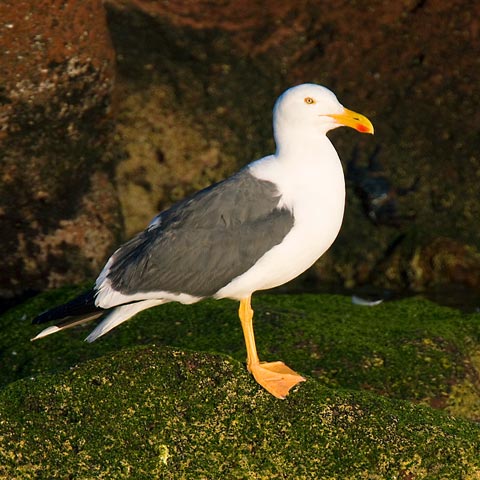 We were now proceeding northwards in the Sea of Cortez, and another landing was first on the agenda the next day, on San Jose Island. A walk here produced
little in the way of new birds, Black-throated Sparrows and Ash-throated Flycatchers being common, but others such as
Costa's Hummingbird being repeats from the previous day. One, however was of particular interest to us, since Western Gulls finally gave way to
Yellow-footed Gulls. Although I had seen one before at the Salton Sea, in common with most US birders it was an immature,
so being able to see and photograph adults was one of my personal targets for the trip. Relatively recently split from Western Gull, it turns out it
should perhaps be called "Vivid-yellow-footed" as all the birds we saw were indeed vivid. Obviously they were in breeding dress, the mantle colour,
however, seemed to vary more than the legs and feet. This was also the first place we saw reptiles, three or four species of lizard, those identified
being Side-blotched lizard, Common Chuckwalla and Western Whiptail.
The afternoon saw us return to cetaceans, but not before seeing many colourful reef fish in the clear water. Our first sighting was another
Blue Whale, followed by another Scalloped Hammerhead Shark and some really close Spiny-tailed Mobulas. A second Blue Whale was seen briefly later, but
most of the afternoon was fairly quiet, although enlivened for those bothering to look (which didn't include the guides) by a couple of
Black Storm-petrels. Apparently numbers were far fewer than normal due to the sea temperature, and we failed to see any other
stormies, although Least could have been expected. As evening approached things livened up a bit, we found a pod of about 800 Long-beaked Common Dolphins,
and three young Humpback Whales. Blue-footed and Brown Boobies began to appear, these two species were
to be much in evidence until the end of the trip.
We were now proceeding northwards in the Sea of Cortez, and another landing was first on the agenda the next day, on San Jose Island. A walk here produced
little in the way of new birds, Black-throated Sparrows and Ash-throated Flycatchers being common, but others such as
Costa's Hummingbird being repeats from the previous day. One, however was of particular interest to us, since Western Gulls finally gave way to
Yellow-footed Gulls. Although I had seen one before at the Salton Sea, in common with most US birders it was an immature,
so being able to see and photograph adults was one of my personal targets for the trip. Relatively recently split from Western Gull, it turns out it
should perhaps be called "Vivid-yellow-footed" as all the birds we saw were indeed vivid. Obviously they were in breeding dress, the mantle colour,
however, seemed to vary more than the legs and feet. This was also the first place we saw reptiles, three or four species of lizard, those identified
being Side-blotched lizard, Common Chuckwalla and Western Whiptail.
The afternoon saw us return to cetaceans, but not before seeing many colourful reef fish in the clear water. Our first sighting was another
Blue Whale, followed by another Scalloped Hammerhead Shark and some really close Spiny-tailed Mobulas. A second Blue Whale was seen briefly later, but
most of the afternoon was fairly quiet, although enlivened for those bothering to look (which didn't include the guides) by a couple of
Black Storm-petrels. Apparently numbers were far fewer than normal due to the sea temperature, and we failed to see any other
stormies, although Least could have been expected. As evening approached things livened up a bit, we found a pod of about 800 Long-beaked Common Dolphins,
and three young Humpback Whales. Blue-footed and Brown Boobies began to appear, these two species were
to be much in evidence until the end of the trip.
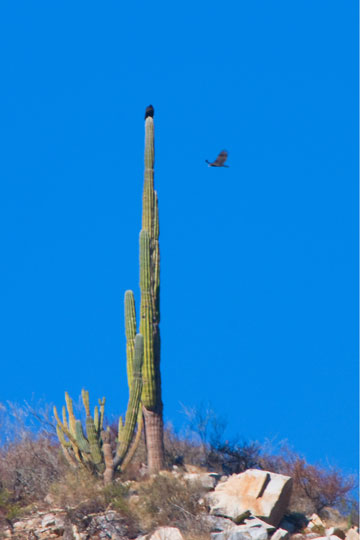
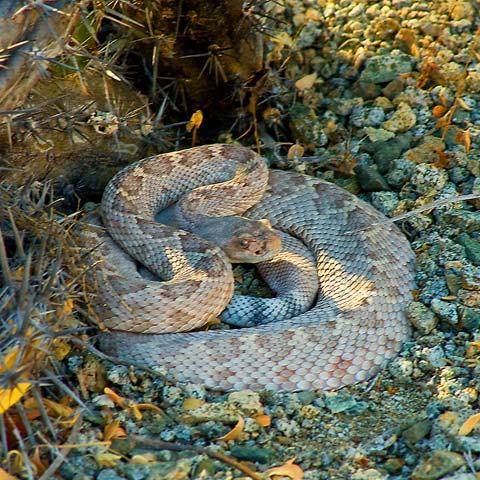 The boat anchored for the night just off Santa Catalina Island, and as the sun rose went for a walk up the wash. Spectacular cacti were the main
feature here, including Barrel Cactus (apparently endemic) and Cardon Cacti, which are nature's ultimate phallic symbol. I tried to photograph
one with a Turkey Vulture on top, to give an idea of scale -you can see the Vulture but it's hardly large enough to
identify! Birds were mainly those seen previously, but Blue-grey Gnatcatcher, Loggerhead Shrike
and, best of all, Gila Woodpecker were new. The other main interest on Catalina is the Santa Catalina
rattlesnake, an endemic, of which we found one basking under a bush. It is probably better known as Rattleless Rattlesnake, the only one in
the world. Thankfully the lack of a warning also renders it rather non-aggresive, allowing a safe close approach, although nobody tried to emulate
the TV "experts" and pick it up! It is venomous, but has probably evolved where there are few predators so its calm nature and lack of a warning rattle
become understandable, whilst there are plenty of Pocket Gophers around for it to prey on.
Another endemic, the Santa Catalina Side-blotched lizard was much in evidence, along with
other lizards and a colony of "Killer" Bees which we avoided. Our afternoon on the boat yielded little new apart from a couple of seabirds. The first
of these, a Red-billed Tropicbird, sat on the water and allowed the boat to approach really closely, perhaps because it was
a juvenile, as they often fly when a good distance away. The other bird, unfortunately only seen somewhat distantly in flight as it was a "lifer" for us,
was Craveri's Murrelet, a couple of pairs of which were seen. The highlight of the day was another Blue Whale, which we saw dive
at least five times, the first with a superb show of flukes. Unlike Humpbacks, they often dive without lifting their flukes out of the water, so we were
quite lucky, all the more so as all this was at minimal distance, the animal completely unconcerned by our prescence.
Common Dolphins returned in some numbers in the evening, and we had a superb display of bioluminescence, including the dolphins, after dark. Above us the sky was
crystal clear, and the desert air enabled a show of stars to equal anywhere in the world, with no light pollution. We anchored for the night in the
San Jose Channel, still part of the Sea of Cortez.
The boat anchored for the night just off Santa Catalina Island, and as the sun rose went for a walk up the wash. Spectacular cacti were the main
feature here, including Barrel Cactus (apparently endemic) and Cardon Cacti, which are nature's ultimate phallic symbol. I tried to photograph
one with a Turkey Vulture on top, to give an idea of scale -you can see the Vulture but it's hardly large enough to
identify! Birds were mainly those seen previously, but Blue-grey Gnatcatcher, Loggerhead Shrike
and, best of all, Gila Woodpecker were new. The other main interest on Catalina is the Santa Catalina
rattlesnake, an endemic, of which we found one basking under a bush. It is probably better known as Rattleless Rattlesnake, the only one in
the world. Thankfully the lack of a warning also renders it rather non-aggresive, allowing a safe close approach, although nobody tried to emulate
the TV "experts" and pick it up! It is venomous, but has probably evolved where there are few predators so its calm nature and lack of a warning rattle
become understandable, whilst there are plenty of Pocket Gophers around for it to prey on.
Another endemic, the Santa Catalina Side-blotched lizard was much in evidence, along with
other lizards and a colony of "Killer" Bees which we avoided. Our afternoon on the boat yielded little new apart from a couple of seabirds. The first
of these, a Red-billed Tropicbird, sat on the water and allowed the boat to approach really closely, perhaps because it was
a juvenile, as they often fly when a good distance away. The other bird, unfortunately only seen somewhat distantly in flight as it was a "lifer" for us,
was Craveri's Murrelet, a couple of pairs of which were seen. The highlight of the day was another Blue Whale, which we saw dive
at least five times, the first with a superb show of flukes. Unlike Humpbacks, they often dive without lifting their flukes out of the water, so we were
quite lucky, all the more so as all this was at minimal distance, the animal completely unconcerned by our prescence.
Common Dolphins returned in some numbers in the evening, and we had a superb display of bioluminescence, including the dolphins, after dark. Above us the sky was
crystal clear, and the desert air enabled a show of stars to equal anywhere in the world, with no light pollution. We anchored for the night in the
San Jose Channel, still part of the Sea of Cortez.
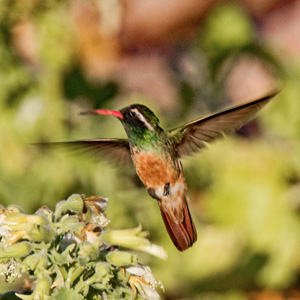
 The next morning we were anchored apparently near a small community called Nopolo, although there was little evidence of
habitation. We went for an early morning walk, greeted by a Spotted Sandpiper in a small stream just behind the beach.
Most of my time was spent trying to photograph Xantu's Hummingbird, endemic to Baja and a bird I had been getting
a little concerned that we hadn't seen up to now. Here there were plenty, but little else out of the ordinary except another new bird for the trip,
a Western Tanager, and good views of Hooded Oriole and Phainopepla,
both of which we had seen in San Diego.
We set off early to look for cetaceans, and (according to the "Official" trip report) some people saw a Dwarf Sperm Whale.
However the tannoy didn't seem to be working again and we made no attempt to follow or wait for it to surface. Having seen Kogi ssp. before I know
they can be unexciting to say the least, quite apart from the fact that Dwarf and Pygmy are almost impossible to separate, but I'm sure many
people would have liked to at least try for another sighting. Bottlenose Dolphins were again in evidence, we stayed with them for a while until
another Blue Whale was spotted. This was the start of the best experience of the trip with "the largest animal that has ever lived", as there were
no less than five in the area, sometimes all visible at the same time, and one dived repeatedly showing its flukes. Many of my photos show the
adjacent coastline, proving how close these large cetaceans will come to land, shame they don't occur in the North Atlantic!
The late afternoon saw us near a school of baitfish pushed to the surface by Yellow Jacks. This in turn attracted other predators, including Boobies
and Frigatebirds, and another Scalloped Hammerhead. An unusual Booby turned out to be a young Nazca Booby, the only
one of the trip, which was reported as a Masked on the "official" tour report. Another Scalloped Hammerhead appeared, and those that were on one
side of the boat, including Ann, were treated to a good view of a Sailfish. Needless to say, I was on the other side!
The next morning we were anchored apparently near a small community called Nopolo, although there was little evidence of
habitation. We went for an early morning walk, greeted by a Spotted Sandpiper in a small stream just behind the beach.
Most of my time was spent trying to photograph Xantu's Hummingbird, endemic to Baja and a bird I had been getting
a little concerned that we hadn't seen up to now. Here there were plenty, but little else out of the ordinary except another new bird for the trip,
a Western Tanager, and good views of Hooded Oriole and Phainopepla,
both of which we had seen in San Diego.
We set off early to look for cetaceans, and (according to the "Official" trip report) some people saw a Dwarf Sperm Whale.
However the tannoy didn't seem to be working again and we made no attempt to follow or wait for it to surface. Having seen Kogi ssp. before I know
they can be unexciting to say the least, quite apart from the fact that Dwarf and Pygmy are almost impossible to separate, but I'm sure many
people would have liked to at least try for another sighting. Bottlenose Dolphins were again in evidence, we stayed with them for a while until
another Blue Whale was spotted. This was the start of the best experience of the trip with "the largest animal that has ever lived", as there were
no less than five in the area, sometimes all visible at the same time, and one dived repeatedly showing its flukes. Many of my photos show the
adjacent coastline, proving how close these large cetaceans will come to land, shame they don't occur in the North Atlantic!
The late afternoon saw us near a school of baitfish pushed to the surface by Yellow Jacks. This in turn attracted other predators, including Boobies
and Frigatebirds, and another Scalloped Hammerhead. An unusual Booby turned out to be a young Nazca Booby, the only
one of the trip, which was reported as a Masked on the "official" tour report. Another Scalloped Hammerhead appeared, and those that were on one
side of the boat, including Ann, were treated to a good view of a Sailfish. Needless to say, I was on the other side!
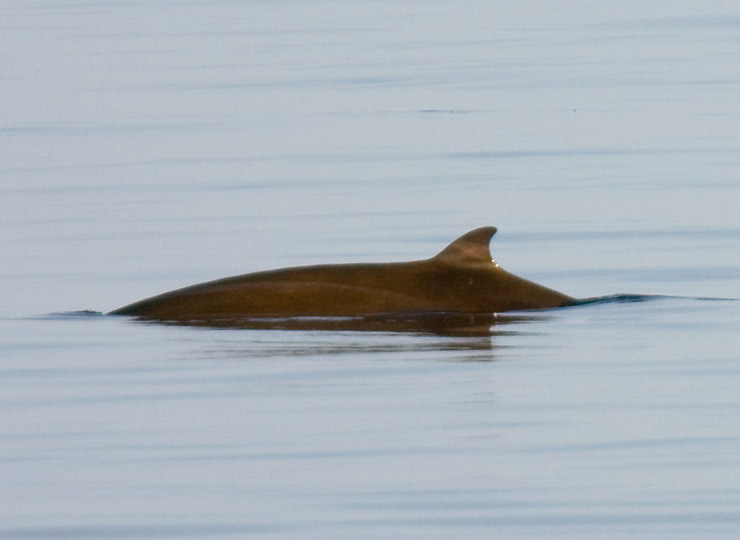 After the activity had died down we came across a
Thresher Shark on the surface, its impossibly
long tail sticking out of the water. These sharks are bottom feeders and, whilst they leap out of the water occasionally, rarely swim on the
surface, so we were lucky with this one.
Even luckier was our next cetacean sighting, to a real cetacean enthusiast this would have been "mammal of the trip". Whilst we stayed with it
for some time, it didn't do much, and all we saw was a small brown whale with an definite melon and a fairly large falcate fin far back on the
body. Obviously a beaked whale, there was much discussion as to its identity, most of it pointless as little is known about many species and it
certainly wasn't one of the better-known ones! However, by a process of elimination as much as anything it was determined to be a
Longman's Beaked Whale, in itself a bit of an enigma since it may be a synonymous species with Southern Bottlenose.
At any rate, it's never been recorded on this trip before, so a megatick! Just a minute though, we can't be absolutely certain of the identity,
glad it wasn't a bird! As we hadn't actually moved that far all day, being in the San Jose
channel and spending most of our time near San Jose Island, this is obviously a prime area for many kinds of wildlife, the great thing about this
trip is the unpredictability of the sightings from year to year, although most are regular, it's the "extras" that make it interesting.
After the activity had died down we came across a
Thresher Shark on the surface, its impossibly
long tail sticking out of the water. These sharks are bottom feeders and, whilst they leap out of the water occasionally, rarely swim on the
surface, so we were lucky with this one.
Even luckier was our next cetacean sighting, to a real cetacean enthusiast this would have been "mammal of the trip". Whilst we stayed with it
for some time, it didn't do much, and all we saw was a small brown whale with an definite melon and a fairly large falcate fin far back on the
body. Obviously a beaked whale, there was much discussion as to its identity, most of it pointless as little is known about many species and it
certainly wasn't one of the better-known ones! However, by a process of elimination as much as anything it was determined to be a
Longman's Beaked Whale, in itself a bit of an enigma since it may be a synonymous species with Southern Bottlenose.
At any rate, it's never been recorded on this trip before, so a megatick! Just a minute though, we can't be absolutely certain of the identity,
glad it wasn't a bird! As we hadn't actually moved that far all day, being in the San Jose
channel and spending most of our time near San Jose Island, this is obviously a prime area for many kinds of wildlife, the great thing about this
trip is the unpredictability of the sightings from year to year, although most are regular, it's the "extras" that make it interesting.
Our last full day on the boat was to provide another such spectacle. We left anchor early and went to a pile of volcanic rocks which apparently have
a name, Cayo Rocco. These were covered in seabirds, Frigatebirds, Pelicans and Gulls in the main, and were bright white in the morning sun from
years of accumulated guano. Breakfast having been eaten by 7.00 am, we were just underway and heading south towards the southern tip of Baja
(from where we would fly home) when the tannoy, so silent so often, announced "two Killer Whales ahead". This was the "icing on the cake" for
most people, many of whom had never seen an Orca. Ann and I were preparing to be a bit blase about the sighting,
having seen Orcas on several trips, but this was to be a bit different.
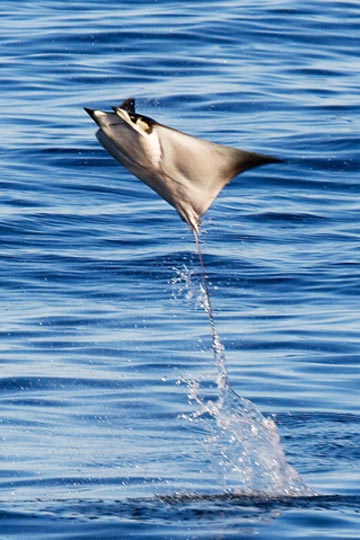

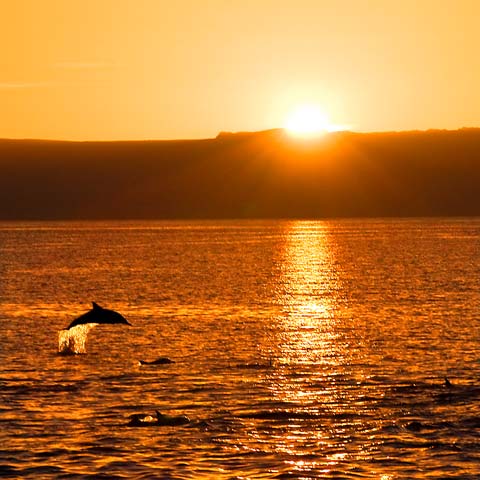 We assumed the two were a pair, and were enjoying the sighting when the male suddenly swam
straight at the boat, down the side and under the stern, skilfully avoiding the propellors! However, this was only the beginning. Orcas aren't
seen every year on this trip, and a pair on its own is an unusual sighting in itself. Whether motivated by a protective instinct toward the
female, curiosity, or even a desire to play (they are after all, not Whales but Dolphins), his behaviour was repeated several times over the
next four and a half hours, giving amazing views. It turns out we covered about twenty miles, lucky in that we were going in the same direction,
although whether we were following them or vice versa I'm not sure.Eventually we lost contact and anchored off another volcanic outcrop
at the northern end of Isla Espiritu Santu. Here we had lunch and put the skiffs out for anyone that wished, for close up views of colourful
fish, sealions and numerous seabirds. These included more Heermann's Gulls, including adults, and also close-up views of Black Turnstone on the rocks.
Continuing south we had another amazing experience off the southern end of the island. Here large numbers
of the other manta ray, the Smooth-tailed Mobula, congregate and undergo what is thought to possibly be a mating ritual.
This involves them leaping out of the water, sometimes singly, at other times several at once. Although one of the smaller species they reach
heights up to twice their own "wingspan", and then just flop on the surface with a resounding splash.
To cap it all, we saw the Orcas again much later, the male reversing his course to swim under our bow again, and spent the evening watching
them and the sunset. Not a bad day considering it was the first day since leaving San Diego that a whale hadn't been sighted! However, normal
service was resumed on our last (half) day, as just before entering the harbour at Cabo San Lucas, from where we were to fly home, three
Humpbacks, including a mother and calf, put on a display as we rounded the headland.
We assumed the two were a pair, and were enjoying the sighting when the male suddenly swam
straight at the boat, down the side and under the stern, skilfully avoiding the propellors! However, this was only the beginning. Orcas aren't
seen every year on this trip, and a pair on its own is an unusual sighting in itself. Whether motivated by a protective instinct toward the
female, curiosity, or even a desire to play (they are after all, not Whales but Dolphins), his behaviour was repeated several times over the
next four and a half hours, giving amazing views. It turns out we covered about twenty miles, lucky in that we were going in the same direction,
although whether we were following them or vice versa I'm not sure.Eventually we lost contact and anchored off another volcanic outcrop
at the northern end of Isla Espiritu Santu. Here we had lunch and put the skiffs out for anyone that wished, for close up views of colourful
fish, sealions and numerous seabirds. These included more Heermann's Gulls, including adults, and also close-up views of Black Turnstone on the rocks.
Continuing south we had another amazing experience off the southern end of the island. Here large numbers
of the other manta ray, the Smooth-tailed Mobula, congregate and undergo what is thought to possibly be a mating ritual.
This involves them leaping out of the water, sometimes singly, at other times several at once. Although one of the smaller species they reach
heights up to twice their own "wingspan", and then just flop on the surface with a resounding splash.
To cap it all, we saw the Orcas again much later, the male reversing his course to swim under our bow again, and spent the evening watching
them and the sunset. Not a bad day considering it was the first day since leaving San Diego that a whale hadn't been sighted! However, normal
service was resumed on our last (half) day, as just before entering the harbour at Cabo San Lucas, from where we were to fly home, three
Humpbacks, including a mother and calf, put on a display as we rounded the headland.
|












